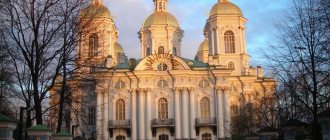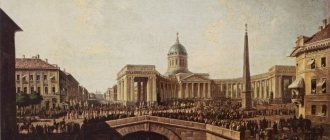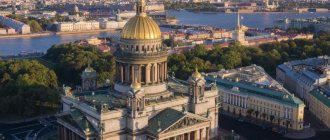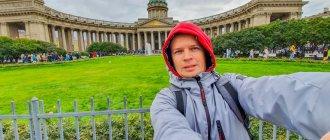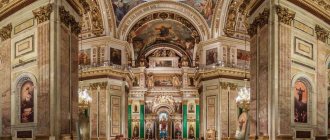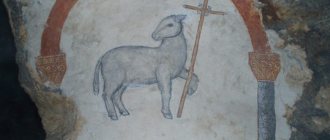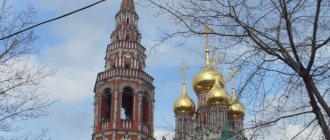The Yekaterinburg Church on the Blood in the name of All Saints who shone forth in the Russian land is one of the main attractions of the city. The Voznesenskaya Gorka area has become notorious throughout the world. It was here that until 1977 the house of engineer Nikolai Nikolaevich Ipatiev stood, in which the last Russian Emperor Nicholas II with his family and servants were shot.
© Elena
Because of this event, which occurred on the night of July 16-17, 1918, the temple received its name. The Church on the Blood is visited not only by religious parishioners, but also by tourist groups. Most often, it is included as part of a city sightseeing tour. He considers it one of the most popular temples in the country. The Ekaterinburg Temple became the third “Church-on-the-Blood” after Uglich and St. Petersburg.
© Anna Kudryavtseva
The architectural complex includes the five-domed main church, the Elizabeth Chapel and the Patriarchal Compound. Together with several other temples, it forms the “Holy Quarter”. It includes the Ascension Church and the Church of St. Nicholas the Wonderworker.
History of the appearance of the temple
In 1917, under the pressure of revolutionaries, Nicholas II
renounced the throne and was exiled with his entire family to Tobolsk.
Later, with the outbreak of the civil war, the royal family was transported to Yekaterinburg and placed under lock and key in the mansion of engineer Ipatiev
, whose house had previously been confiscated by the Bolsheviks. It was assumed that members of the imperial family would soon be taken to Moscow to be presented before the court. But this was not destined to happen: on the night of July 16-17, 1917, Nicholas II, his wife, children and associates of the former tsar were driven into the basement of the house and there they were shot. The bodies of the dead were first taken down a mine on Ganina Yama, and a day later they were securely hidden.
Cross, in memory of the imperial family
In the late 70s, the Ipatiev Mansion
demolished. After the weakening of the totalitarian regime, people began to increasingly come to the site again, wanting to honor the memory of the victims who ended their lives in the basement of the demolished mansion. The first forerunner of the temple was a wooden cross, which was soon replaced by an iron one. The cross still stands near the cathedral to this day, reminiscent of that terrible night.
History of construction
On July 17, 1918, in the basement of the Ipatiev estate, the family of Tsar Nicholas II and his assistants were shot in cold blood. Tsar Nicholas II had no intention of fleeing or starting a rebellion; the royal persons behaved with dignity in captivity and constantly prayed, so it is difficult to explain the cruelty of the murder.
Icon of the Holy Royal Passion-Bearers
Shame and repentance filled the souls of Russians all these years; for 60 years, fresh flowers were constantly brought to the holy place, until a decision was made to perpetuate the memory of the innocently murdered members of the royal family, whose bodies were simply thrown into a mine after execution.
Architecture of the Temple on the Blood
The laying of the stone foundation of the cathedral took place back in 1992
, but for economic reasons construction was frozen.
A couple of years later, the first Divine Liturgy took place on the site of the future church. Construction work was resumed only in 2000. After 3 years, the temple was built and consecrated. Soon it was joined by the Patriarchal Compound
and
the Elizabeth Chapel
.
The cathedral is made in the Russian-Byzantine style, as if recalling the origins of Orthodoxy. The temple reaches a height of 60 meters, has 5 golden domes and 14 bells, one of which weighs more than 5 tons. A special bell was named after St. Andrew the First-Called
and sounds lower than all other bells.
The domes crowning the cathedral create the feeling of an unquenchable fire burning in memory of the victims. The red granite border
, like a ribbon encircling the structure, reminds of the terrible bloodshed.
Also along the perimeter of the cathedral you can see 48 bronze icons
with the faces of highly revered Russian saints.
Gallery of icons
According to the architects' idea, the cathedral was divided into two levels - lower and upper. Ground floor, also known as the Memorial for the Romanovs
, is a dark basement with a low ceiling, most similar to the basement of Ipatiev’s mansion. It contains the original remains of the engineer's house. This was done on purpose in order to fully experience the moment of the death of the king and his relatives. An altar was installed at the murder site, and next to it there is a museum complex where you can learn everything about the last days of the Romanovs’ life. For greater convenience, an auditorium with 160 seats is equipped in this part of the temple.
Temple architecture
The upper part of the temple is bright and spacious. There you will see a unique iconostasis made of rare white marble. The length of the iconostasis reaches 30 meters, height - 13 meters. Both levels are connected by a through passage that comes out of the base and abuts the iconostasis of the upper part of the temple. Looking through this opening, you can see the place of death of the king and his family.
In front of the temple there is a sculptural composition consisting of 7 figures. The monument commemorates the descent of the entire Romanov family into the basement, where their lives ended.
Excursions and prices
Several sightseeing programs have been developed for visiting the museum. Excursions to the Savior on Spilled Blood will allow you to get acquainted with its architecture, history and attractions.
The price of excursions to the Cathedral of the Savior on Spilled Blood is 400 rubles. The duration of any program is 45 minutes.
Savior on Spilled Blood: outside and inside
The tour will begin at the Arts Square, from where you will walk with a guide to the museum, learning about life in the 19th century in St. Petersburg along the way. In the cathedral you will see famous mosaics and carved iconostases. The guide will tell you about the history of the temple from its foundation to modern days, about its secrets and the emperor to whom this monument was erected. After visiting the Savior on Spilled Blood, you will go to the Campus of Mars, where you will learn about the Russian Empire during the revolution.
Type: group, walking.
Duration: 2 hours.
Cost: 590 rubles.
Learn more about the excursion and book online
Gospel stories in the mosaics of the temple
The cathedral's mosaics are one of its main attractions. The scenes embodied on the walls of the cathedral tell about 277 Christian characters, and the number of depicted walls totals 68 scenes. The tour will take guests up close and personal with the impressive mosaics.
Mosaic of the Church of the Savior on Spilled Blood
On this excursion, guests will learn not only about the subjects and characters of the cathedral's mosaics, but also learn about the history of the mosaic ensemble. The guide will tell you about how and by whom the sketches were created, about the masters who created the works of art, as well as the nuances of the technique for creating such drawings.
Architecture and exterior decoration
The excursion will introduce guests to the amazing cathedral, made in Russian style. They will be able to see it from all sides, and the program will not leave a single detail of the external and internal decoration unnoticed.
Schedule of services and events
Every year on a memorable night, from July 16 to 17, a service is held in the temple in memory of the victims, and then a religious procession is organized to Ganina Yama
, where the bodies of the dead were originally dumped. The number of people wishing to attend this event is increasing every year.
Chapel on the site of the room where the royal family was killed
You can visit the Ekaterinburg Church on the Blood any day from 7:30 to 23:00. They come to services in the morning and evening, and confess during the daytime.
Today, the church hosts various Orthodox projects, such as Sunday and art schools, a children's choir, a cadet class, a lecture hall “Fundamentals of Orthodoxy” and even a library.
To a greater extent, the cathedral is perceived as a museum or memorial, which attracts pilgrims from different parts of the world and interested tourists. A visit to the temple is often included in a sightseeing tour of Yekaterinburg.
Start of construction
In the spring, construction of the Church on the Blood began in Yekaterinburg, in the process of preparation for which, unfortunately, century-old trees, witnesses of the walks of the royal family, were cut down. Archaeologists conducted thorough excavations, recording the site of the Ipatiev basement, where terrible events took place.
Important! At the Jubilee Council of Bishops, the Royal Family was canonized as the Holy Passion-Bearers.
On September 22-23, the Bishop's Compound of Yekaterinburg was visited for the first time by the First Hierarch of the Russian Orthodox Church, Patriarch Alexy II, who consecrated the capsule and the Memorial Certificate during the consecration of the construction of a new church in Yekaterinburg.
Church on the Blood in Yekaterinburg
In the spring of 2001, the construction of the zero cycle was completed and the construction of the above-ground part began, which was consecrated during a prayer service. The first bricks were laid by Bishop Vincent and Governor Eduard Rossel.
- At the beginning of summer, with the blessing of His Holiness the Patriarch, construction began on the patriarchal courtyard and the Center for Spiritual Enlightenment at the Church of All Saints.
- The consecration of the small bells, for the production of which singer Alexander Novikov donated funds, took place on October 6, 2002.
- In December, we began installing a unique iconostasis, the parts of which are made of faience.
- In January 2003, the iconostasis was installed and the installation of the marble iconostasis on the upper tier began.
- In May, after the consecration, the belfry of the Church on the Blood was equipped with multi-ton bells and a ten-meter-high cross.
- In June, Princess Olga Kulikovskaya-Romanova donated to the church the holy image of the Mother of God “Three-Handed”; the captives cried out to God around it; the Mother of God witnessed the brutal murder.
On a note!
On July 16, the consecration of the Church on the Blood took place; more than 70 representatives of the clergy took part in the ceremony. The monumental event of Orthodoxy attracted the attention of all of Russia. The Orthodox of Tobolsk came in a procession of the cross, carrying the holy images of St. John of Tobolsk and the Holy Royal Passion-Bearers. Residents of Volgograd came in a procession of repentance.
Many famous politicians, artists, and businessmen took part in the consecration celebration, which began in front of the holy image of Seraphim of Sarov, transferred from the Cathedral of the Holy Trinity of the Seraphim-Diveevsky Monastery. At night, the Liturgy took place, after which more than seven thousand parishioners went in a procession to Ganina Yama, the place where the holy bodies were destroyed.
Worship at the Church on the Blood
The morning Divine Liturgy, celebrated in the lower altar, marked the beginning of regular services in the newly built cathedral, which became a holy place for all Orthodox believers in Russia and the whole world.
June 18 is the church patronal feast day in honor of All the saints who have shone in the Russian land.
The church operates:
- Cossack club;
- Sunday Church;
- Family Club;
- compassionate services and other schools.
How to get there
The church ensemble is located in the very center of the city. There are several stops around the temple, the closest to it is “Youth Theater”. Therefore, it is more convenient to get to it by ground transport. This:
- buses No. 1, 13, 13a, 15, 018, 21, 23, 48, 53, 57 and 57a;
- trolleybuses No. 1, 3, 5, 9, 11, 15, 17, 18;
- minibuses No. 021, 052 and 056.
If you decide to get to the cathedral by metro, then you need to get to the Dynamo station and walk 750 meters along the square. Here you can see several city attractions: the Cosmos concert hall, the Literary Quarter and the City Pond.
Visiting rules
On the territory of the museum you are not allowed to go beyond the fences or touch the elements of the interior decoration. You cannot carry or consume drinks or food, or ride a bicycle, rollerblades or other means of transportation. The only exceptions are persons with disabilities.
Persons in a state of intoxication are not allowed into the museum. You cannot take suitcases or other large bags with you.
Photography can only be carried out without the use of specialized equipment, including a monopod, and without a flash.
Savior on Spilled Blood - Cathedral of the Resurrection of Christ on Spilled Blood
The Savior on Spilled Blood is an Orthodox church in St. Petersburg, whose full name is the Cathedral of the Resurrection of Christ on the Blood (also the Church of the Savior on Spilled Blood).
Savior on Spilled Blood
The cathedral got its name from the place on which it was built. It was here that on March 1 (new style - 13) 1881 an attempt was made on Emperor Alexander II, as a result of which he was wounded and soon died. The expression in the name of the temple “on the blood” is an indication of the blood of the emperor.
Thus, the Savior on Spilled Blood is a monument to the martyr king. Today it is also an architectural monument, as well as a museum that is part of the museum complex “State Museum-Monument “St. Isaac’s Cathedral”.
Emperor Alexander II
The cathedral is located in the city center on the embankment of the Griboyedov Canal. Nearby is one of the most famous parks of the Northern capital - the Mikhailovsky Garden, as well as one of the central squares of the city - Konyushennaya, which got its name from the Imperial stable yard of Catherine I.
Construction of the cathedral was started by order of the son of Alexander II, Emperor Alexander III. The initial design of the temple belonged to two architects: Alfred Parlande, for whom the Savior on Spilled Blood became the most famous work, and the rector of the Trinity-Sergius Hermitage, Archimandrite Ignatius (Malyshev), who eventually moved away from the construction of the temple, as a result of which it was erected entirely according to Parlande’s design .
Alfred Parland
Located in the historical center of St. Petersburg, the Cathedral of the Resurrection of Christ on the Blood invariably attracts the attention of tourists. The appearance of the temple plays an important role in this. The Savior on Spilled Blood was built in the Russian style and to a certain extent was an imitation of the Cathedral of the Intercession of the Blessed Virgin Mary on the Moat, better known as St. Basil's Cathedral (Cathedral) in Moscow. In addition, the architectural landmarks of the cathedral were the churches of Moscow and Yaroslavl of the 16th-17th centuries.
The construction of the temple took 24 years. Thus, the construction work that began in 1883 was completed only in 1907. It was this year that the temple was consecrated on August 6 (in the new style - August 19) by Metropolitan Anthony (Vadkovsky).
From the moment of the death of Alexander II and until the start of construction of the Savior on Spilled Blood, a chapel was located at the site of the assassination attempt on the emperor, the decision to erect it was made the very next day after the death of the tsar at an emergency meeting of the City Duma. The chapel was erected at the expense of the merchants Gromov and Militin (the latter of whom became the headman, that is, he was in charge of the economy of the church community), and its architect was Leonty Benois.
Chapel at the site of the death of Alexander II
The consecration of the chapel happened quite quickly, already on April 17 (29) of the same 1881. After her appearance, memorial services began to be held here. The chapel remained on the site of its original construction until the construction of the cathedral began, that is, until 1883. After that it was moved to Konyushennaya Square. The facility remained in its new location for nine years, after which it was completely dismantled.
After the decision was made to build a cathedral at the site of the assassination attempt on the emperor, a competition was announced for the best project, in which the authors of 26 works took part. From among the presented projects, 8 best were selected, among which the first place was won by A. Timoshko’s project, which involved the construction of a cathedral in the Russian-Byzantine style. The work was called “To the Father of the Fatherland.” In second place was the project “March 1, 1881” by academicians I. Kitner and A. Gun. The project of L. Benoit, who was the author of the chapel located on the same site, took third place. However, none of the selected projects was approved by Alexander III, as a result of which it was decided to hold a second competition, to which 31 projects were submitted. However, all new projects were also rejected by the head of state.
After this, it was decided to hold another competition, as a result of which the project of the architect Alfred Parland and Archimandrite Ignatius (Malyshev) won. However, this project was approved with the condition of its further refinement. The approval of the initial project took place in the summer of 1883, and its final version was approved only in May 1887.
Project of the Church of Archimandrite Ignatius
Construction of the Church of the Savior on Spilled Blood began in October 1883. The construction commission was headed by Grand Duke Vladimir Alexandrovich, the third son of Alexander II. The construction, which took 24 years, was completed in August 1907, when on the day of the Transfiguration of the Lord, also known as the Second Savior, the consecration of the cathedral took place in the presence of Emperor Nicholas II and members of the imperial family.
The construction of the temple, for which money was collected throughout the country, cost 4.6 million rubles.
The following year, 1908, next to the temple, the Chapel-sacristy of the Iveron Icon of the Mother of God, which is a separate building, was consecrated. Although, according to the original project proposed by Archimandrite Ignatius, it was planned to build two chapels, which were corner turrets located on the fence of the cathedral. The chapel, the construction of which was completed in 1907, together with the Church of the Savior on Blood, was consecrated by Metropolitan Anthony of St. Petersburg and Ladoga. Its main purpose was to be used for storing icons and other gifts that were presented in memory of the death of Alexander II. In addition, archival materials concerning the construction of the temple were stored in the chapel-sacristy.
Iverskaya chapel-sacristy
It is noteworthy that the Cathedral of the Resurrection of Christ on the Blood was built using new construction technologies. The building was fully electrified: it housed almost 1,700 electric lamps.
Another interesting fact is that the Savior on Spilled Blood was not a parish church, but was supported by the state. The cathedral was under the jurisdiction of the Ministry of Internal Affairs; mass visits to the temple were not envisaged, although its capacity was quite large: the cathedral can accommodate up to 1,600 people. Under imperial power, entry to the temple was carried out only with passes.
Savior on Spilled Blood is inside
In 1920, after a change of government, the church became a parish church, although the rector of the cathedral, Archpriest Peter Leporsky, objected to this decision.
From July 1922 until July of the following year, the cathedral belonged to Petrograd autocephaly, after which it became Renovationist. Since August 1923, it became the cathedral of the “Old Church” (“Tikhon’s”) Petrograd diocese, and from the end of 1927 it became the center of Josephiteism in Leningrad. On October 30, 1930, the temple was closed, and a year later it was decided to dismantle the building. However, the timing of this procedure was not specified, and therefore the Savior on Spilled Blood stood until the beginning of the Great Patriotic War, when other issues arose before the authorities.
During wartime, the Savior on Spilled Blood served as a morgue; the bodies of dead townspeople were placed here, and after the war, the scenery warehouse of the Maly Opera House was located here.
Shell marks
In 1968, the temple was transferred under the protection of the State Inspectorate for the Protection of Monuments; two years later, a decision was made to organize a branch of the St. Isaac's Cathedral Museum here, which is what it is today.
During the 1970-90s, engineering, general construction and restoration work was carried out in the building. In August 1997, the Savior on Spilled Blood opened to its first visitors, and on May 23, 2004, the first liturgy was served here after a break of several decades. Almost ten years later, in January 2014, a church parish was registered here.
Today anyone can see the Savior on Spilled Blood in all its glory. Moreover, you can admire the cathedral both outside and inside. Architecturally, the compositional center of the building is a quadrangle topped with five domes. In addition, the cathedral has four more chapters. In total, the temple is an asymmetrical group topped with five domes, some of which are gilded and some are enamel. The central head of the temple is a tent, the height of which reaches 81 meters.
Cathedral domes
On the outside walls of the temple there are inscriptions telling about the achievements of Russia during the reign of Emperor Alexander II. Various finishing materials were used in the design of the building, including brick, marble and granite, as well as enamels, gilded copper and mosaics.
There are especially many mosaics in the interior of the temple. It was created in the workshop of Russian mosaic artist Vladimir Frolov. The works were carried out according to sketches by more than 30 artists, including world-famous authors. Today, the mosaic exhibition of the Savior on Spilled Blood represents one of the largest collections in all of Europe.
Cathedral mosaic
When visiting the Cathedral of the Resurrection of Christ on the Blood, you should also pay special attention to the chapel-sacristy, which today is a historical and cultural monument of federal significance and is used for organizing and holding exhibitions.
The structure has a rectangular shape, topped with a large dome, on top of which there is a chrisma - a monogram of the name of Jesus Christ (made in the form of the Greek letters “chi”, “rho”, “alpha” and “omega” inscribed in a circle). Brick is used in the decoration of the building, and the decorations are tiles and mosaic icons. Around the chapel there is a fence similar to the one that separates the Savior on Spilled Blood from the St. Michael's Garden.
Interior decoration of the Church of the Savior on Spilled Blood in St. Petersburg
The cathedral was not designed for mass attendance. This influenced its interior decoration, which is striking in its beauty. The decoration includes a collection of Russian mosaics of that time. Inside, it completely covers the walls, pylons, vaults and domes.
156177
author: Dmitry Kazakov
In the cathedral we see a rich collection of gems, jewelry enamel, colored tiles, made by the best craftsmen. Craftsmen from the Yekaterinburg, Kolyvan and Peterhof lapidary factories took part in creating the decoration of the cathedral.
156213
author: Dmitry Kazakov
Of the variety of mosaics and mosaic compositions, it is necessary to note the works made according to originals by artists V.M. Vasnetsova, M.V. Nesterova, A.P. Ryabushkina, N.N. Kharlamova, V.V. Belyaeva.
156240
author: Dmitry Kazakov
The cathedral's mosaic collection is one of the largest in Europe. Ornamental and semi-precious stones were used as decorative decoration for the interior of the cathedral, with which the iconostasis, walls and floor of the building were lined.
156221
author: Dmitry Kazakov
156220
author: Dmitry Kazakov
156226
author: Dmitry Kazakov
For the iconostasis, icons were made according to the sketches of Nesterov and Vasnetsov - “The Mother of God and the Child” and “The Savior”.
156242
author: Dmitry Kazakov
156241
author: Dmitry Kazakov
Particularly significant in the temple, after the altar, was the place where the assassination attempt on Emperor Alexander took place. A canopy was built over a fragment of the cobblestone street, a special structure that was supported by columns of gray-violet jasper. At the top of the canopy stood a topaz cross.
156192
author: Dmitry Kazakov
Under the canopy are kept the relics of the cathedral - part of the grating of the Catherine Canal and the cobblestones on which the mortally wounded Alexander II fell.
156193
author: Dmitry Kazakov
Forests stood around the cathedral for a very long time. And the people said that the forests would stand as long as Soviet power stood. It's possible that this is a coincidence. But the scaffolding was dismantled shortly before the August events in Moscow in 1991.
The Church of the Savior on Spilled Blood is the first temple built on the site where the emperor of the state died. The constructed architectural monument was a symbol of the impending revolution.



